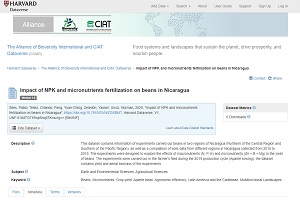Agro-nutrition baseline survey data of 20 villages in the Kitui district (Kenya), in 2008
This is a baseline survey data that was collected within the project ‘Managing agricultural biodiversity for better nutrition and health, improved livelihoods and more sustainable production systems in sub-Saharan Africa’ implemented by Bioversity International. The survey was conducted in Kitui District in Eastern Province of Kenya in September 2008. The area was chosen for best testing the research hypothesis: In rural farming communities there exists a relationship between access to local agrobiodiversity (domesticated, weedy and immediate wild) and dietary diversity which in turn has some link to nutritional and health status. Factors considered while choosing the area included: i) differential access to agrobiodiverisity among different communities living in close proximity, ii) easy access to the site, iii) high diversity of traditional foods and iv) richness in local knowledge. A structured questionnaire was formulated to determine following 5 features , i) Demographic data, ii) Preliminary socio-economic status and livelihoods sources, iii) Morbidity, iv) Food frequency and v) Anthropometric measurements of child and mother/caretaker. Anthropometric measurements were done on children 6-59 months as well as their mothers or caretakers. Through individual interview at the household visit, the questionnaire was administered to 1,000 households at an average of 50 homesteads per village. One or two enumerators were recruited from each of the 20 villages with the help of local leaders and provided for the training. The thousand (1,000) households representing 20 villages, 10 villages in intervention (treatment) area, 10 villages in none-intervention (control) area, were selected from a group of 60 villages which had been subjected to a clustering process based on soils, vegetation, agroecology, altitude and number of crop growing days per year, forming 6 clusters. From each of the 6 cluster groups (A-F), 1 or 2 target villages were selected randomly such that for each treatment village, there was a corresponding control village with similar characteristics (Sheet 4). Each village had 150-200 households. The households are defined as members of a family served from the same pot. About 50 households which has children under the age of 5 years and above 6 months were randomly selected for study in each village. In order to establish a cause and effect relationship between the Agrobiodiversity, dietary diversity and nutrition/health, the research design combines two methods: 1) A“cross-sectional research design’ that surveys status only once and 2) a control group design where there is a control and treatment group (Sheet 6).

